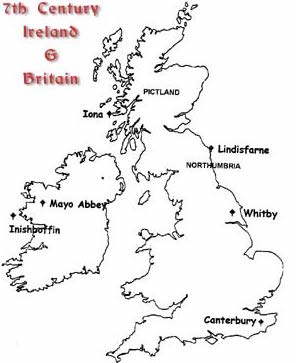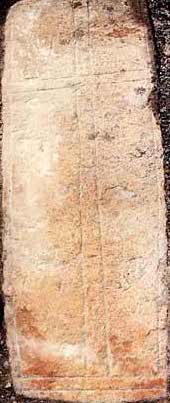A History of Mayo Abbey
General Introduction
Mayo Abbey as a traceable community, was already three hundred years old when Viking Dublin was founded.
St Colman
The history of Mayo begins with the Synod of Whitby in 664, to resolve the conflict between the Celts and the Romans on the date of Easter.
Having lost the debate St Colman left Lindisfarne and returned to Iona, later going to Innisboffin and from there to Maigh Eo, later to become known as Mayo of the Saxons.
At the time when St Colman founded Mayo, Ireland was divided into 100 Tuaths (Kingdoms). St Colman was probably a nobleman of Canmaicne.
On leaving Innisboffin following a split between the Irish and Saxon monks he was given a site by the king.
This was probably a sparsely populated area close to the border of another kingdom, as it happened Mayo was situated on the north of Canmaicne where it bordered the kingdoms of Cera and Magcaeir.
When St Colman came to Mayo he brought with him half the relics of Lindisfarne, including a part of the true cross which was reputed to be in Mayo Abbey till the Reformation in 1537, when it vanished.
The first mentiion of Mayo is in Bede's "History of the English people" in the 10th century.
The Church laws - Lex Innoncentium - by which women were forbidden to take part in the dangers of battle are reputed to be written by Adamnan while in Mayo in 696 - 97. Adamnan's well is still in use today.
The foundation developed links in its first 300 years with Scotland, England, The Lowlands and Germany.
First Millennium
By the end of the first millennium, it was an urban community of an estimated 3,000 people with an interactive rural hinterland and a European presence of some importance, both ecclesiastically, with it's monks ranked sixth in importance at the synods of Canterbury, and politically, as noted in the correspondence between it and the Court of Charlemagne King of the Franks and Holy Roman Emperor (768 - 814) in Aachen.
Alcuin the English translator to Charlemagne sought advice from the monks of Mayo on the ecclesiastical reforms of the 770's.
Mayo became a diocese in 1152 and survived till it's union with Tuam in 1631. Bishop Patrick O'Healy who, with Fr Con O'Rourke, was captured by the British in Limerick on their way to Mayo and executed for the faith in Limerick in 1570. They were beatified in 1994.
The last Bishop of Mayo was Adam Maguran who went to Nantes in France on unification of the two diocese. Mayo of the Saxons was a place of learning equal to that of Augsburg and Regensburg and others of the period in mainland Europe.
1176 - Donal, brother of Rory O'Connor, last High King of Ireland died and is buried in Mayo Abbey. In 1400 it became an Augustinian Abbey with approx 4,000 acres of land.
In 1619 King James 1 granted a licence to John and Sarah Paulette to distill and sell uisce beaha (whiskey) in the barony of Clanmorris and the County of Mayo. This business is still carried on today in Byrne's pub.
During the penal times the lands were owned by various landlords; Brownes of Brownhall, Blakes of Ballinafad, Kirwans of Galway. During this period the parishioners openly worshipped in defiance of the law inside a church on the site of the Famine church - a 19th century building which is one of few unaltered pre-famine churches in the country.
Second Millennium
At the start of the second millennium the course of Irish history changed with the Battle of Clontarf and the defeat of the Vikings. At that time in Europe the Irish were the first people to introduce surnames.
The town of Mayo flourished till the 16th century, when like other towns outside the Pale it declined, but enough remained for Sir Henry Sidney who divided Connaught into counties to name the county of Mayo after the town of Mayo in 1570.
The names of many of the early Saints appear in the Annals as having studied at, or visited Mayo of the Saxons.
When one looks at Mayo Abbey today all one sees is the ruins of a 15th century monastery. Though now a rural community with an Archaeological site of national and international importance Mayo Abbey has been fortunate in that it has laid undisturbed for over 1300 years and is now classed as an Archaeological goldmine by experts in that field.
The old graveyard is a layered graveyard and is in continuous use for over 1300 years.
Mayo Abbey also posesses one of the oldest pub licences in the country.


Bishop Patrick O'Healy Memorial Centre
Mayo Abbey
County Mayo
+353 94 936 5987
mayoabbey@eircom.net
Sneak Peek
Some interesting items can be viewed here